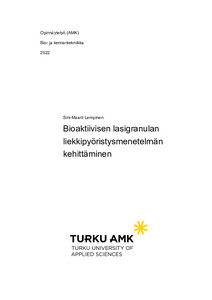Bioaktiivisen lasigranulan liekkipyöristysmenetelmän kehittäminen
Lempinen, Sini-Maarit (2022)
Lempinen, Sini-Maarit
2022
All rights reserved. This publication is copyrighted. You may download, display and print it for Your own personal use. Commercial use is prohibited.
Julkaisun pysyvä osoite on
https://urn.fi/URN:NBN:fi:amk-2022091420145
https://urn.fi/URN:NBN:fi:amk-2022091420145
Tiivistelmä
Opinnäytetyön toimeksiantajana toimi BonAlive Biomaterials Ltd, joka tuottaa lääkinnällisiä laitteita luukudosvauroihin bioaktiivista S53P4-lasia hyödyntäen. Bonalive granules -tuotteissa lasi on murskattu granuloiksi, mutta Bonalive putty- ja putty MIS-tuotteissa käytetään lisäksi pyöreitä lasihelmiä. Niiden ansiosta tuote on helpommin injektoitavissa, jolloin leikkaus voidaan suorittaa pienemmästä haavasta.
Työn tarkoituksena oli kehittää liekkipyöristysmenetelmää, johon edeltävän kehitysprojektin perusteella oli valittu asetyleeniliekki. Työn keskeisiksi testattaviksi parametreiksi valittiin lasigranulan syöttönopeus ja -kohta, syöttökohdan etäisyys polttimesta sekä asetyleenin ja paineilman virtausnopeuksien suhde. Tavoitteena oli saada pyöristettyä granulasta yli 95 %.
Testiajot suoritettiin BonAliven tiloissa. Tulosten arvioimista varten näytteistä otettiin SEM-kuvat Åbo Akademilla. Kuvista saatiin näyttöä optimaalisesta syöttökohdasta, mutta niiden perusteella lopulliseen tavoitteeseen ei päästy. Tulosten pohjalta on kuitenkin helpompi jatkaa menetelmän jatkokehitystä. This thesis project was carried out for BonAlive Biomaterials Ltd, which produces medical devices to repair bone tissue defects out of bioactive glass S53P4. The Bonalive granules product family uses granules of bioactive glass, whereas in Bonalive putty and putty MIS products, also glass spheres are added, making the product easier to inject. Therefore, surgery can be performed with a smaller incision.
The main objective of this project was to develop flame spheroidization. The development was initially commenced with a master’s thesis project in 2021. According to the results of the previous project, acetylene was utilized as the source of the flame. The current project focused on testing the effect of granule feeding rate, feeding point on both x- and z-axis, and the ratio of the flow rates of acetylene and pressurized air. The aim was to spheroidize a minimum of 95 percent of granules.
The test runs were executed at BonAlive. For evaluation of results, SEM images of samples were taken. The results showed the most optimal feeding point but the objective was not reached during this project. However, the results of this project will help develop flame spheroidization in the future.
Työn tarkoituksena oli kehittää liekkipyöristysmenetelmää, johon edeltävän kehitysprojektin perusteella oli valittu asetyleeniliekki. Työn keskeisiksi testattaviksi parametreiksi valittiin lasigranulan syöttönopeus ja -kohta, syöttökohdan etäisyys polttimesta sekä asetyleenin ja paineilman virtausnopeuksien suhde. Tavoitteena oli saada pyöristettyä granulasta yli 95 %.
Testiajot suoritettiin BonAliven tiloissa. Tulosten arvioimista varten näytteistä otettiin SEM-kuvat Åbo Akademilla. Kuvista saatiin näyttöä optimaalisesta syöttökohdasta, mutta niiden perusteella lopulliseen tavoitteeseen ei päästy. Tulosten pohjalta on kuitenkin helpompi jatkaa menetelmän jatkokehitystä.
The main objective of this project was to develop flame spheroidization. The development was initially commenced with a master’s thesis project in 2021. According to the results of the previous project, acetylene was utilized as the source of the flame. The current project focused on testing the effect of granule feeding rate, feeding point on both x- and z-axis, and the ratio of the flow rates of acetylene and pressurized air. The aim was to spheroidize a minimum of 95 percent of granules.
The test runs were executed at BonAlive. For evaluation of results, SEM images of samples were taken. The results showed the most optimal feeding point but the objective was not reached during this project. However, the results of this project will help develop flame spheroidization in the future.
